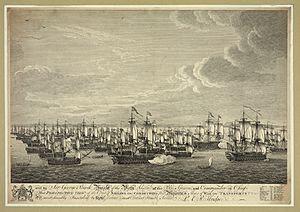HMS Edgar (1758) facts for kids
Quick facts for kids History |
|
|---|---|
| Name | HMS Edgar |
| Ordered | 19 April 1756 |
| Builder | Randall, Rotherhithe |
| Launched | 16 November 1758 |
| Fate | Sunk as a breakwater, 1774 |
| General characteristics | |
| Class and type | Edgar-class ship of the line |
| Tons burthen | 1297 42⁄94 bm |
| Length | 154 ft (47 m) (gundeck) |
| Beam | 43 ft 6 in (13.26 m) |
| Depth of hold | 18 ft 4 in (5.59 m) |
| Propulsion | Sails |
| Sail plan | Full-rigged ship |
| Armament |
|
HMS Edgar was a powerful sailing ship with 60 guns, part of the Royal Navy (Britain's navy). She was launched, meaning she touched the water for the first time, on November 16, 1758, in a place called Rotherhithe. A famous doctor named Thomas Denman even worked on Edgar for a few years. Later, in 1774, she was sunk on purpose to help protect a harbor.
Contents
The Story of HMS Edgar
HMS Edgar was a type of warship known as a ship of the line. These were large, powerful ships that formed the main battle line of a navy. Edgar had 60 guns, which made her a "fourth-rate" ship. This meant she was a strong vessel, but not the very biggest.
Building and First Adventures
The order to build Edgar was given on April 13, 1756. She was built in Rotherhithe and was named on September 13, 1758. Just two months later, on November 16, 1758, she was launched into the water.
After her launch, Edgar was prepared for duty at Deptford Dockyard. This process cost about £27,627, which was a huge amount of money back then! In December 1758, Captain Francis William Drake took command of the ship.
Edgar quickly joined the action. On April 14, 1759, she sailed to join the British fleet in the Mediterranean Sea. She took part in the important Battle of Lagos on August 19, 1759, where the British won a big victory.
In 1760, Edgar moved to the Western Squadron, another part of the British fleet. She helped capture Belle Île, an island off the coast of France, in June 1761.
Sailing to Jamaica and Havana
On February 26, 1762, Edgar set sail for Jamaica. There, she joined the Leeward Islands Station, a group of ships protecting British interests in the Caribbean.
While in the Caribbean, Edgar played a role in the Siege of Havana. This was a major battle where British forces captured the city of Havana in Cuba from the Spanish. The siege lasted from June 6 to August 13, 1762.
After the war ended in 1763, Edgar returned home to Britain. When a ship was "paid off," it meant her crew left, and she was taken out of active service for a while. At this time, the ship's doctor, Thomas Denman, also left the ship.
Guarding the Docks
Edgar was brought back into service in December 1763. Captain George Collier took command. Her new job was to be a "guardship" at Plymouth Dockyard. A guardship protected the important naval base and its ships. She started this role in February 1764.
For a short time on January 4, 1765, Edgar sailed to the coast of Africa. But by the next year, she was back at Plymouth, continuing her guardship duties.
Over the next few years, new captains took command. Captain Robert Carpenter replaced Captain Collier in 1767. Then, Captain the Honourable Henry St. John took over in 1771.
A New Purpose
In June 1771, Captain St. John paid off Edgar again. On July 30, the ship was inspected. The inspection showed that Edgar was getting old and might not be suitable for fighting anymore.
So, on March 23, 1774, a decision was made. Edgar would be turned into a breakwater for Sheerness Dockyard. A breakwater is a structure built to protect a harbor or coastline from strong waves. Old ships were sometimes sunk on purpose to create these barriers.
The work to prepare Edgar for this new role was done at Chatham Dockyard. On June 8, she was sailed to Sheerness. Finally, in August, HMS Edgar was sunk into place to become a breakwater. Her remains were later taken apart in 1775.


